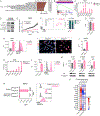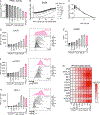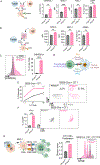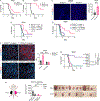PP2Ac Deficiency Enhances Tumor Immunogenicity by Activating STING-Type I Interferon Signaling in Glioblastoma
- PMID: 37219874
- PMCID: PMC10525036
- DOI: 10.1158/0008-5472.CAN-22-3382
PP2Ac Deficiency Enhances Tumor Immunogenicity by Activating STING-Type I Interferon Signaling in Glioblastoma
Abstract
Glioblastoma (GBM) is an immunologically "cold" tumor that does not respond to current immunotherapy. Here, we demonstrate a fundamental role for the α-isoform of the catalytic subunit of protein phosphatase-2A (PP2Ac) in regulating glioma immunogenicity. Genetic ablation of PP2Ac in glioma cells enhanced double-stranded DNA (dsDNA) production and cGAS-type I IFN signaling, MHC-I expression, and tumor mutational burden. In coculture experiments, PP2Ac deficiency in glioma cells promoted dendritic cell (DC) cross-presentation and clonal expansion of CD8+ T cells. In vivo, PP2Ac depletion sensitized tumors to immune-checkpoint blockade and radiotherapy treatment. Single-cell analysis demonstrated that PP2Ac deficiency increased CD8+ T-cell, natural killer cell, and DC accumulation and reduced immunosuppressive tumor-associated macrophages. Furthermore, loss of PP2Ac increased IFN signaling in myeloid and tumor cells and reduced expression of a tumor gene signature associated with worse patient survival in The Cancer Genome Atlas. Collectively, this study establishes a novel role for PP2Ac in inhibiting dsDNA-cGAS-STING signaling to suppress antitumor immunity in glioma.
Significance: PP2Ac deficiency promotes cGAS-STING signaling in glioma to induce a tumor-suppressive immune microenvironment, highlighting PP2Ac as a potential therapeutic target to enhance tumor immunogenicity and improve response to immunotherapy.
©2023 American Association for Cancer Research.
Conflict of interest statement
Figures







References
-
- . Tamimi AF, Juweid M. Epidemiology and Outcome of Glioblastoma [Internet]. Glioblastoma 2017. Available from: http://www.ncbi.nlm.nih.gov/pubmed/29251870 - PubMed
Publication types
MeSH terms
Substances
Grants and funding
LinkOut - more resources
Full Text Sources
Molecular Biology Databases
Research Materials

